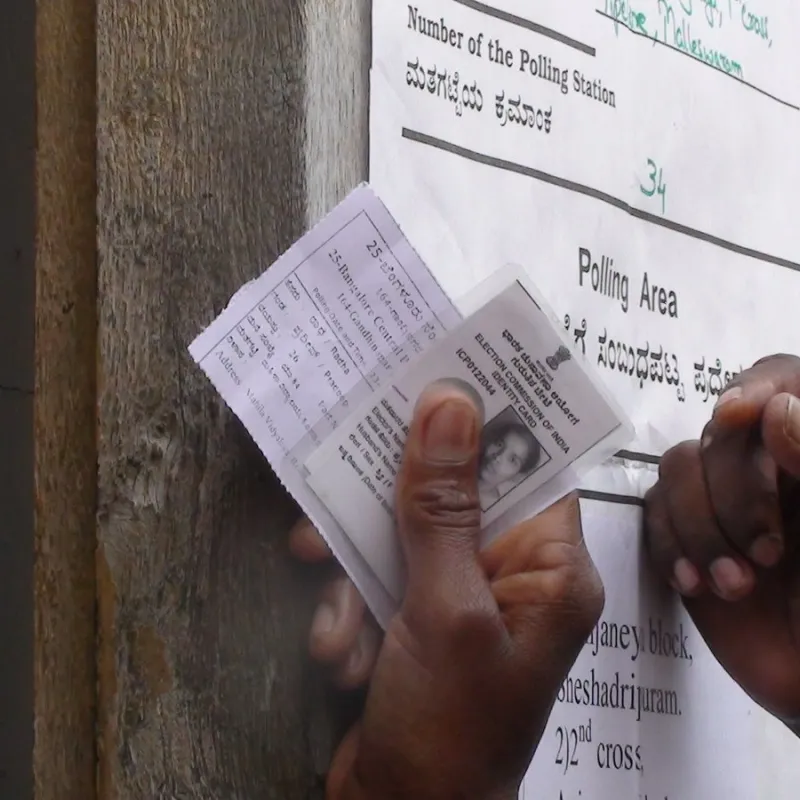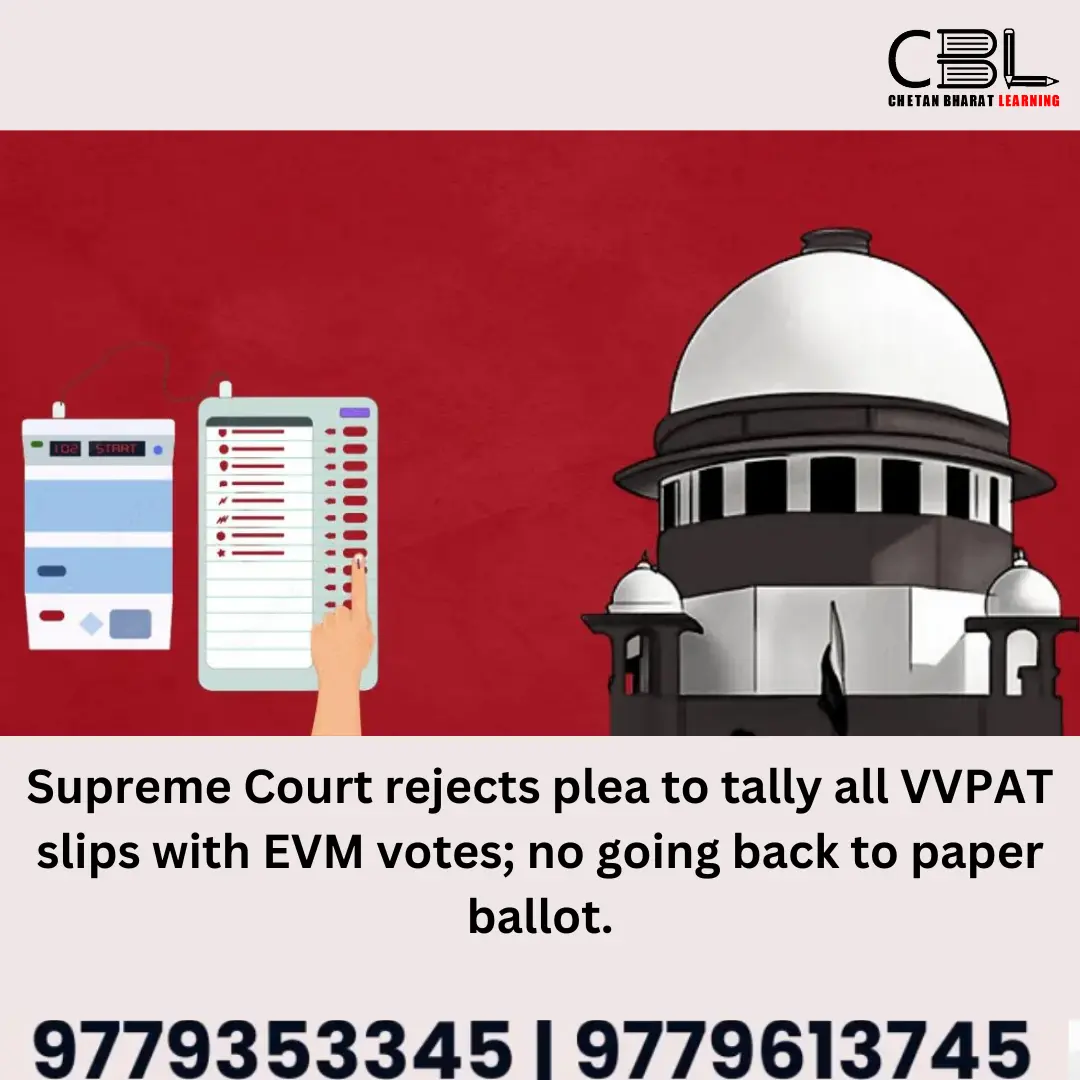Why in the news?
On Friday, April 26, the Supreme Court of India dismissed the plea for 100% verification of Voter Verified Paper Audit Trail (VVPAT) in Indian elections.
Evolution of voting in India
- Manual Voting (1950s-1990s):
- Initially, voting in India was conducted manually using paper ballots.
- Voters marked their choice on a paper ballot with an inked thumbprint or a cross.
- This method was labour-intensive and prone to errors, tampering, and electoral malpractices.
- Introduction of Electronic Voting Machines (EVMs) (1990s):
- In the 1990s, India introduced Electronic Voting Machines (EVMs) to modernise the voting process.
- EVMs replaced paper ballots with electronic machines equipped with push-button panels for voters to select their candidates.
- EVMs were designed to reduce errors, enhance efficiency, and minimise electoral fraud such as booth capturing and ballot stuffing.
- Incremental Improvements to EVMs:
- Over the years, there have been incremental improvements to EVMs, including enhanced security features and usability enhancements.
- The Election Commission of India (ECI) has continuously upgraded EVM technology to address concerns about reliability, security, and transparency.
- Introduction of Voter Verified Paper Audit Trail (VVPAT):
- To enhance transparency and voter confidence in EVMs, India introduced Voter Verified Paper Audit Trail (VVPAT) systems.
- VVPAT provides a printed paper receipt of the voter’s choice, allowing voters to verify their selections before casting their votes electronically.
- Pilot Projects for Remote Voting:
- In recent years, the ECI has initiated pilot projects to explore the feasibility of remote voting mechanisms such as the Electronic Postal Ballot System (EPBS) and Internet Voting (I-Voting).
- These initiatives aim to facilitate voting for Indian citizens residing abroad and members of the armed forces, although widespread implementation is pending.

What are Voter Verified Paper Audit Trails (VVPATs)?
- Introduced in India during the 2014 Lok Sabha elections.
- It comprises two components: the VVPAT Printer and the VVPAT Status Display Unit (VSDU) – connected to Electronic Voting Machines (EVMs).
- Verification Process: Voters can verify that their votes are accurately cast as intended.
- Printing of Slip: When a vote is cast, a slip is printed, containing the candidate’s serial number, name, and symbol.
- Visibility Period: This printed slip remains visible through a transparent window for 7 seconds.
- After the visibility period, the printed slip is automatically cut and falls into the sealed drop box of the VVPAT.

How does the verification process work?
- Verification Process: VVPAT slips kept in drop boxes are used to verify the results of Electronic Voting Machines (EVMs).
- Access and Usage: Only polling officials, not voters, can access VVPAT machines.
- Authority of VVPAT Slips: In cases of fraud or miscalculation allegations, VVPAT slips hold more authority than EVM tallies.
- Occasional Verification: Voter verification through VVPAT is typically done in extreme circumstances, such as accusations of fraud.
- The Election Commission of India (ECI) has the authority to order verification using VVPAT slips in response to complaints.
- Random Selection: Currently, VVPAT slips are counted in randomly selected polling stations in Assembly or Parliamentary constituencies, depending on the type of elections.
- Separate Entities: EVMs and VVPATs are separate entities.
- Manufacturers: The Electronics Corporation of India Limited (ECIL) and Bharat Electronics Ltd (BEL) have developed these machines.
EVM and VVPAT
| Feature | Electronic Voting Machine (EVM) | Voter Verifiable Paper Audit Trail (VVPAT) |
| Purpose | Records and tallies votes electronically without paper trail | Provides a paper trail for voters to verify their votes |
| Components | Main unit with push-button panel | Printer and display unit attached to the EVM |
| Verification | Votes verified electronically, no physical record | Votes verified by printed paper slips |
| Transparency | Limited transparency without paper trail | Enhances transparency by providing a physical record |
| Access | Accessed by polling officials only | Accessible to polling officials, not voters |
| Verification Use | Rarely used unless there are accusations of fraud | Used for verification in extreme circumstances |
| Authority | Election Commission of India (ECI) | ECI has authority to order verification in response to complaints |
| Counting | Electronic tallying of votes | Paper slips counted manually or electronically |
| Manufacturers | Developed by the Electronics Corporation of India Limited (ECIL) and Bharat Electronics Ltd (BEL) | ECIL and BEL also responsible for VVPAT development |
- The Supreme Court dismissed all petitions advocating for complete cross-verification of votes cast via Electronic Voting Machines (EVMs).
- Additionally, the court rejected calls to revert to the previous ballot paper system for elections.
The Case
- In March 2023, the Association for Democratic Reforms (ADR) petitioned the Supreme Court, advocating for cross-verification of Electronic Voting Machines (EVM) data with Voter Verified Paper Audit Trail (VVPAT) slips to ensure fair elections.
- ADR proposed the use of barcodes on VVPAT slips for efficient cross-verification.
- Justice Khanna, while dismissing the petitions, suggested that the Election Commission of India should explore the possibility of using electronic machines to count paper slips and consider incorporating barcodes alongside party symbols for identification.
- In February 2018, the Election Commission (EC) mandated the counting of Voter Verified Paper Audit Trail (VVPAT) slips from one randomly chosen polling station per Assembly constituency.
- Later increased to five polling stations per Assembly seat, following a Supreme Court judgement in April 2019.
- A draw of lots conducted by the Returning Officer in the presence of candidates or their representatives determines the selection of the five polling stations.
Why does the EC not want to count 50% of VVPAT slips?
- The Election Commission (EC) doesn’t want to count 50% of VVPAT slips due to time constraints and logistical challenges.
- They claim it takes about an hour for election officers to match VVPAT slips with EVM counts in one polling station.
- Counting VVPAT slips can only start after tabulating EVM votes. This leads to a potential delay of five hours for five polling stations.
- The EC cites infrastructure issues, like manpower availability, as hurdles to increasing the number of polling booths.
Why are political parties demanding widened verification of VVPAT slips?
- Political parties are demanding expanded verification of Voter Verified Paper Audit Trail (VVPAT) slips to ensure transparency in elections.
- Opposition parties argue that ensuring a fair election is more important than the potential delay in announcing results.
- Parties have requested anywhere from 50% to 100% verification of VVPAT slips.
- However, the Election Commission (EC) has been hesitant to comply.


Leave a Reply
You must be logged in to post a comment.